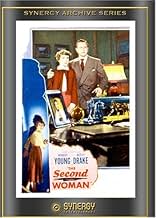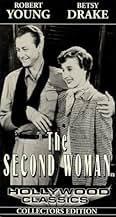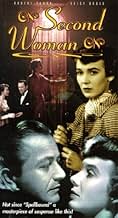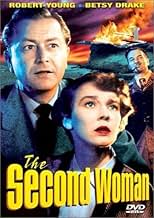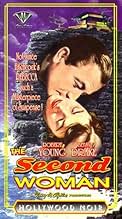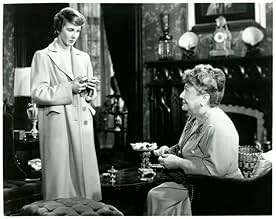PUNTUACIÓN EN IMDb
6,3/10
1,5 mil
TU PUNTUACIÓN
Añade un argumento en tu idiomaIn flashback from a 'Rebecca'-style beginning: Ellen Foster, visiting her aunt on the California coast, meets neighbor Jeff Cohalan and his ultramodern clifftop house.In flashback from a 'Rebecca'-style beginning: Ellen Foster, visiting her aunt on the California coast, meets neighbor Jeff Cohalan and his ultramodern clifftop house.In flashback from a 'Rebecca'-style beginning: Ellen Foster, visiting her aunt on the California coast, meets neighbor Jeff Cohalan and his ultramodern clifftop house.
- Dirección
- Guión
- Reparto principal
Jason Robards Sr.
- Stacy Rogers
- (as Jason Robards)
Jimmie Dodd
- Mr. Nelson
- (as Jimmy Dodd)
Smoki Whitfield
- Porter
- (escenas eliminadas)
Walter Bacon
- Country Club Guest
- (sin acreditar)
Vince Barnett
- Giovanni Strobini
- (sin acreditar)
Paul Bradley
- Country Club Guest
- (sin acreditar)
Reseñas destacadas
The Second Woman is a stylish mystery thriller staring second tier leads Robert Young and Betsy Drake and directed by second tier director James V. Kern. But there is nothing second rate about the finished product. This movie is visually and dramatically stimulating from beginning to end.
Young plays an architect brooding over the death of his fiancé in an auto crash in which he was the driver the previous year. After a series of apparent accidents, including a suspicious injury to his horse and a fire at his house, it appears that either someone is out to get him, or he is actually doing destructive things to himself because he is a dangerously off-his-nut paranoiac. The local doctor (Morris Carnovsky) believes the latter. His newly acquired girl friend (Drake), who works in statistical studies for an insurance company, turns detective to prove it is the former. The mystery unfolds at a leisurely pace at first but gradually builds tension with surprising twists and turns of the plot. As with any good thriller, you begin to suspect everyone. A brooding, almost Gothic mood is maintained by Joseph Nussbaum's haunting Tchaikovsky-based score and Hal Mohr's alternately dark and luminous black and white cinematography. Frequent shots of the surf crashing on the lonely rocks of the Central California shore help set the forlorn ambiance. Kern's direction is precise, dialog is intelligent, editing smooth. Young and Drake are charming, and they get expert support from Carnovsky, Henry O'Neil, Florence Bates, and John Sutton.
The Second Woman successfully blends elements of mystery, noir, Gothic, and romantic melodrama. Though released in July 1950, its sensuous style and feel seem to belong more to the l940's than to the 'fifties. But when decades are accounted properly, the year 1950 is actually the last year of the decade we nickname "the forties". In any case it was made near the end of an era. Due to collapse of the studio systems, death and retirement of key personnel, adverse changes in public taste, and other factors, by the end of the 1950's they would no longer be able to make pictures as classy and entertaining as The Second Woman.
Top entertainment from Hollywood's Golden Era.
Young plays an architect brooding over the death of his fiancé in an auto crash in which he was the driver the previous year. After a series of apparent accidents, including a suspicious injury to his horse and a fire at his house, it appears that either someone is out to get him, or he is actually doing destructive things to himself because he is a dangerously off-his-nut paranoiac. The local doctor (Morris Carnovsky) believes the latter. His newly acquired girl friend (Drake), who works in statistical studies for an insurance company, turns detective to prove it is the former. The mystery unfolds at a leisurely pace at first but gradually builds tension with surprising twists and turns of the plot. As with any good thriller, you begin to suspect everyone. A brooding, almost Gothic mood is maintained by Joseph Nussbaum's haunting Tchaikovsky-based score and Hal Mohr's alternately dark and luminous black and white cinematography. Frequent shots of the surf crashing on the lonely rocks of the Central California shore help set the forlorn ambiance. Kern's direction is precise, dialog is intelligent, editing smooth. Young and Drake are charming, and they get expert support from Carnovsky, Henry O'Neil, Florence Bates, and John Sutton.
The Second Woman successfully blends elements of mystery, noir, Gothic, and romantic melodrama. Though released in July 1950, its sensuous style and feel seem to belong more to the l940's than to the 'fifties. But when decades are accounted properly, the year 1950 is actually the last year of the decade we nickname "the forties". In any case it was made near the end of an era. Due to collapse of the studio systems, death and retirement of key personnel, adverse changes in public taste, and other factors, by the end of the 1950's they would no longer be able to make pictures as classy and entertaining as The Second Woman.
Top entertainment from Hollywood's Golden Era.
A better-than-average psychological thriller, The Second Woman blends aspects of Rebecca and Gaslight into a savvy, neo-Gothic style (there's even an ultramodern, Manderley-like pile of memories high above the crashing ocean; it, too, ends in conflagration).
Robert Young plays a young architect who can't wriggle out from under a jinx. The night before their wedding, a car crash claimed the life of his fiancée, for whom he'd built the cantilevered "house with wings." Now it's a mausoleum where he broods to the Tchaikovsky on the sound track. Lapses of memory and moody episodes undermine his work. His horse, his dog, even his prize rosebush die mysteriously. He's sinking, an object of pity and, increasingly, apprehension.
Into this slough of despond comes a guardian angel (Betsy Drake), an intelligent and independent insurance investigator who falls for him, as he for her. (She's something of an anomaly in film noir, where all the brains and spunk usually go to the wicked women.) She supplies Young with the resolve to solve the puzzle when he ceases to care.
There are weak points as well. The suicide attempt that opens the movie makes scant sense when it's later explained; the character set up as a villain emerges, at least partly, as a red herring; and the formidable Florence Bates disappears into a bland "also-starring" role. And constantly referring to past events in a low-key, almost abstract way lays poor preparation for the ending, where they prove central. Still, The Second Woman keeps you puzzled, and the Gothic trappings work their spell. Less film noir than mystery, it's nonetheless a good, old-fashioned one.
Robert Young plays a young architect who can't wriggle out from under a jinx. The night before their wedding, a car crash claimed the life of his fiancée, for whom he'd built the cantilevered "house with wings." Now it's a mausoleum where he broods to the Tchaikovsky on the sound track. Lapses of memory and moody episodes undermine his work. His horse, his dog, even his prize rosebush die mysteriously. He's sinking, an object of pity and, increasingly, apprehension.
Into this slough of despond comes a guardian angel (Betsy Drake), an intelligent and independent insurance investigator who falls for him, as he for her. (She's something of an anomaly in film noir, where all the brains and spunk usually go to the wicked women.) She supplies Young with the resolve to solve the puzzle when he ceases to care.
There are weak points as well. The suicide attempt that opens the movie makes scant sense when it's later explained; the character set up as a villain emerges, at least partly, as a red herring; and the formidable Florence Bates disappears into a bland "also-starring" role. And constantly referring to past events in a low-key, almost abstract way lays poor preparation for the ending, where they prove central. Still, The Second Woman keeps you puzzled, and the Gothic trappings work their spell. Less film noir than mystery, it's nonetheless a good, old-fashioned one.
The Second Woman (AKA: Ellen) is directed by James V. Kern and co- written by Mort Briskin and Robert Smith. It stars Robert Young, Betsy Drake, John Sutton, Florence Bates, Morris Carnovsky and Henry O'Neil. Music is by Joseph Nussbaum and cinematography by Hal Mohr.
Architect Jeff Cohalan (Young) is a troubled man, after the mysterious death of his fiancée in a car crash, he has been acting strangely and lives a lonely life at the Hilltop House he designed for his bride to be. When he meets Ellen Foster (Drake), things perk up as he becomes attracted to her. But he is constantly plagued by bad luck, something which doesn't go unnoticed by Ellen, who suspects that Jeff may not be the victim of paranoia, but of something sinister perpetrated by outside forces
The Coast of Kings.
If you can get away from the looming presence of such great films like Gaslight and Rebecca, then James Kern's movie holds some Gothic noir rewards. The house at the centre of tale is a modern development, which is a shame as it goes against the coastal atmosphere lifting up from the Carmel-On-Sea location that was used for these parts of the film, but otherwise there's a strong brooding mystery bubbling away throughout. As the bizarre instances of misfortune start to mount up on Jeff Cohalan, with director Kern showing a good appreciation of pacing, it builds up a menacing head of steam and then unravels a better than adequate denouement.
Vivian, Vivian, Vivian
Young and Drake inevitably tug at a romantic thread, but they make for an engaging couple and Drake especially gets her teeth into a female role of intelligent substance. John Sutton files in for some decent caddish quotient and Bates and O'Neil add some professionally elder support. Mohr's (Bullets or Ballets/The Lineup) photography is the key, consistently at one with the psychological beats of the plotting, his lighting compositions make the film seem far more higher in production value than it was.
A tale of memory lapses, pet bothering, depression, ugly real estate, dastards and romance, is nicely cloaked by ominous coastal atmospherics and Tchaikovsky! 7/10
Architect Jeff Cohalan (Young) is a troubled man, after the mysterious death of his fiancée in a car crash, he has been acting strangely and lives a lonely life at the Hilltop House he designed for his bride to be. When he meets Ellen Foster (Drake), things perk up as he becomes attracted to her. But he is constantly plagued by bad luck, something which doesn't go unnoticed by Ellen, who suspects that Jeff may not be the victim of paranoia, but of something sinister perpetrated by outside forces
The Coast of Kings.
If you can get away from the looming presence of such great films like Gaslight and Rebecca, then James Kern's movie holds some Gothic noir rewards. The house at the centre of tale is a modern development, which is a shame as it goes against the coastal atmosphere lifting up from the Carmel-On-Sea location that was used for these parts of the film, but otherwise there's a strong brooding mystery bubbling away throughout. As the bizarre instances of misfortune start to mount up on Jeff Cohalan, with director Kern showing a good appreciation of pacing, it builds up a menacing head of steam and then unravels a better than adequate denouement.
Vivian, Vivian, Vivian
Young and Drake inevitably tug at a romantic thread, but they make for an engaging couple and Drake especially gets her teeth into a female role of intelligent substance. John Sutton files in for some decent caddish quotient and Bates and O'Neil add some professionally elder support. Mohr's (Bullets or Ballets/The Lineup) photography is the key, consistently at one with the psychological beats of the plotting, his lighting compositions make the film seem far more higher in production value than it was.
A tale of memory lapses, pet bothering, depression, ugly real estate, dastards and romance, is nicely cloaked by ominous coastal atmospherics and Tchaikovsky! 7/10
This fine "B" film project is basically a psychological film, in the category of the many 1940s and 50s films that were made to explore depth-of-character and motivation. The idea their producers had was to go beyond the inspector calling and assembling suspects in the drawing room to detail who'd done a murder; in the newer mysteries, emphasis was placed upon gradually discovering clues and lines of inquiry, upon revealing actions, pretenses, questionings and complex relationships. This "modern" peeling away of layers of truth relating to an old crime's influence often works brilliantly in my judgment, especially in this movie, Not the least of this unpretentious and beautifully- photographed work's accomplishments is its avoidance of Freudian and false notions that so often muddy attempts to understand individuals' characters in film; Freud applies only to totalitarian societies. Here the investigator is in fact a beautiful woman, very intelligently played as insurance expert and woman-in-love by Betsy Drake. The object of her interest is a man who may or may not be crazy, well-portrayed by Robert Young. He has been suffering a series of accidents or breakdowns that are ruining his life; he has begun to doubt his own sanity. But she insightfully feelss someone is trying to wreck his career and his hopes for happiness. Their search for the perpetrator of the acts being done against him help them to unravel the mystery of his late wife's death and the secrets of the usual nasty small United States town and its equally small-minded citizens (a favorite target of intellectuals in the period, genuinely or not). The director was James V. Kerns, the cinematographer Hal Mohr, whose work was outstanding also. The cast apart from the attractive and bright leads was comprised of Morris Carnovsky, Jean Rogers, Steven Geray, Shirley Ballard, John Sutton and Florence Bates, all well-cast and in top form.. This film was an attempt to do on a low-budget what "Spellbound" had been able to accomplish; the house architect Young designs is outstanding modern architecture; the music by Bernard Nussbaum and the Tschaikovsky excerpts used are I believe add to the atmosphere very nicely. And the relations between characters, acerbic or warm, are unusually well-realized in dialogs and blocking.. This is a true sleeper, with its roots in "The Fountainhead"; and one that deserves much more attention that it has ever received; many elements of an intriguing mystery-noir storyline are quite successfully filmed here indeed.
I really enjoyed this film. It has a fairly believable premise. I do have a little trouble with the self-sacrifice angle and the idea of taking things to the grave that could be dealt with, but it has lots of suspense and a cool ending. Robert Young is carrying around a secret. He is being daily harassed by someone. His dog is killed, his house is burned, his horse is harmed (to the point where it needs to be destroyed), and his livelihood (as an architect) is being compromised. He meets a young woman who makes him happy, but she can't convince him to come clean. There is a plot to portray him as psychotic (actually paranoid), He seems to have some handle on everything but won't say what it is. There is excellent cinematography. The pacing is quite good. I have to admit I never suspected what was going on. It's a captivating film. The acting is quite good. Oh, yes, as I see these films, I have seen the presence of Jimmy Dodd who was the head Mousketeer on the old Mickey Mouse Club show of the fifties. His acting portfolio is rather extensive though unimpressive.
¿Sabías que...?
- CuriosidadesAt the beginning of the movie, Robert Young's character tries to commit suicide by running his car engine in an enclosed garage. Then in flashback, the doctor says that he's concerned about Young's character's recurring bouts of depression. In real life, Young suffered from depression for decades, and tried to commit suicide in Westlake Village, CA in January 1991 by running a hose from his exhaust pipe into the interior of his car. Young called a tow truck to try to start his car. The driver noticed the hose, and contacted the police.
- PifiasIn the opening scene, Robert Young's character is discovered suffocated by heavy carbon monoxide in a sealed garage, but nobody else coming in the garage is affected by the deadly gas. Additionally, unless a car is burning oil or running very rich, exhaust fumes are not visible as was shown here. This reveals some type of smoke or vapor was used, not an actual auto exhaust.
- Citas
Jeff Cohalan: Let's see what the tea leaves say about you... there's a trick my grandmother taught me; she learned it from an old witch in Ireland.
Ellen Foster: And so you've been drinking coffee ever since.
- ConexionesReferenced in This Movie Must Die!: The Second Woman (1950) (2021)
Selecciones populares
Inicia sesión para calificar y añadir a tu lista para recibir recomendaciones personalizadas
- How long is The Second Woman?Con tecnología de Alexa
Detalles
- Duración
- 1h 31min(91 min)
- Color
- Relación de aspecto
- 1.33 : 1
Contribuir a esta página
Sugerir un cambio o añadir el contenido que falta

